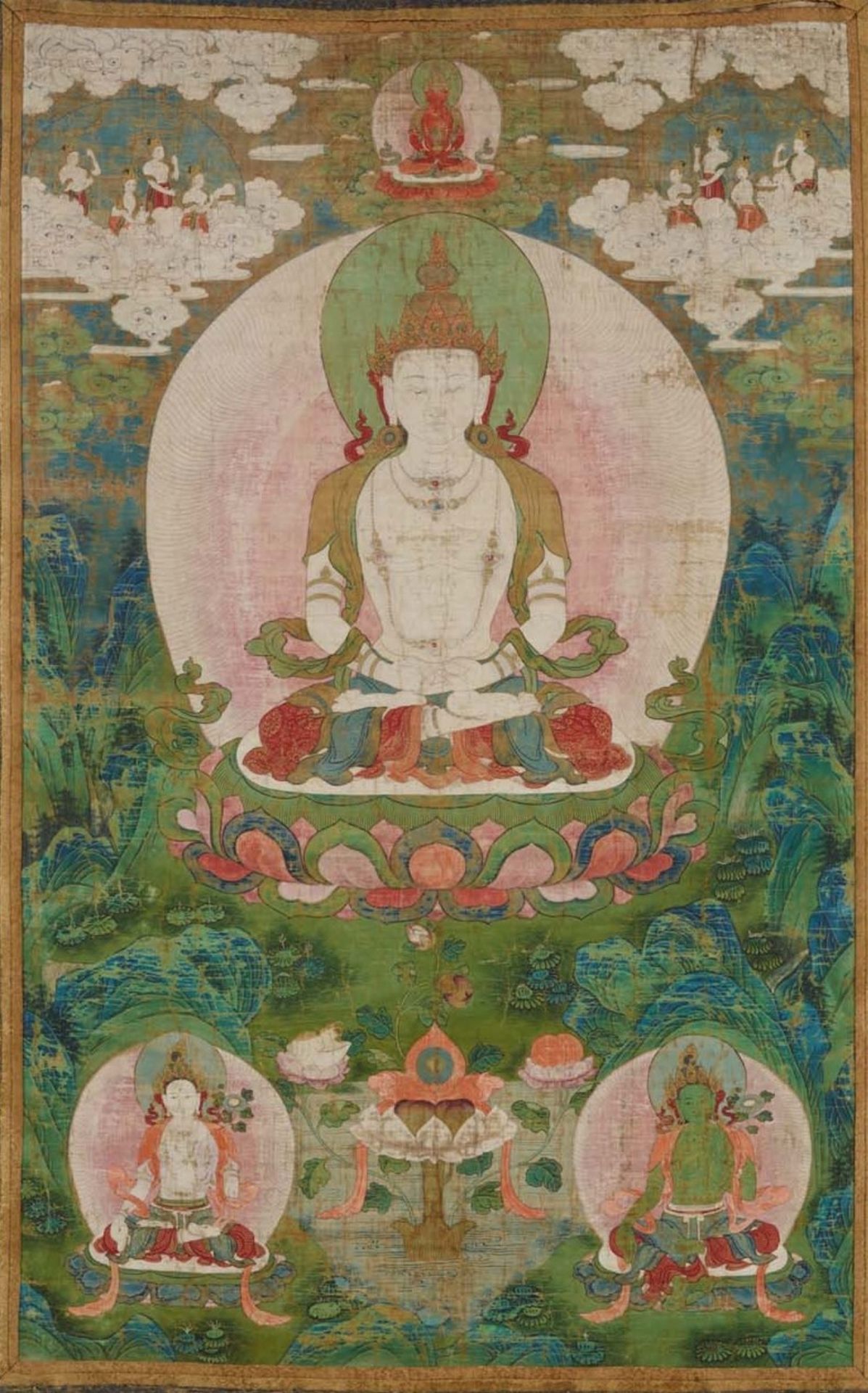Description
A rare Chinese thangka of a bodhisattva. China, Chengde, Xumi Fushou Temple. Qianlong period. 1179-1780 Seated in meditative posture on a lotus in a soft pink aureole filled with fine gold lines, dressed in a dhoti with gold floral motivs and a billowing sash, adorned with foliate jewellery and backed by a green halo, with Amitayus at the top centre, flanked by eight heavenly offering goddesses, at the bottom left appears the White Tara and on the right the Green Tara, at the bottom centre are the symbolic offerings of the five enjoyments, all placed in a green mountainous landscape. Brocade mounting. The present painting is one of a set likely commissioned for the Xumifushou Temple in Chengde, outside Beijing, which was built by the Qianlong Emperor to celebrate his seventieth birthday in 1780. The Temple was a replica of the Tashi Lhunpo Monastery, seat of the Panchen Lama in Tibet, and was filled with countless paintings, sculptures, and other ritual objects of Tibetan style. Most probably there exist several sets of very similar paintings commissioned for the Xumifushou Temple. It is also likely that several copies of a set were produced at the same time, both for decorating new temples and also for gift exchange during the time of Emperor Qianlong. The composition of the paintings of these Sets are all uniform in that there is Amitayus at the top centre and the White and the Green Tara at the bottom right and left side, all against a background derived from Chinese blue-and-green landscapes. 114 x 70.5 cm Provenance Martin Fischer (13.4.1882 Gernrode-23.1.1961 Hamburg), who was ambassador to Beijing and other towns of China from 1907-1918, and thence by descent Literature Compare two very similar paintings, the one illustrated in: Himalayan Art Resources (himalayanart.org), no. 24448, sold at Christie´s, New York, 12.9.2018, lot 315 and the other sold at Sotheby´s, Hong Kong, 7.4.2015, lot 3653. Compare also a similar painting from the collection of the Asian Art Museum, San Francisco, acc. no. B72D67, illustrated in Himalayan Art Resources (himalayanart.org), no. 69453. An inscription on this painting says that it comes from the Ximifushou Temple.
48
A rare Chinese thangka of a bodhisattva. China, Chengde, Xumi Fushou Temple. Qianlong period. 1179-1780 Seated in meditative posture on a lotus in a soft pink aureole filled with fine gold lines, dressed in a dhoti with gold floral motivs and a billowing sash, adorned with foliate jewellery and backed by a green halo, with Amitayus at the top centre, flanked by eight heavenly offering goddesses, at the bottom left appears the White Tara and on the right the Green Tara, at the bottom centre are the symbolic offerings of the five enjoyments, all placed in a green mountainous landscape. Brocade mounting. The present painting is one of a set likely commissioned for the Xumifushou Temple in Chengde, outside Beijing, which was built by the Qianlong Emperor to celebrate his seventieth birthday in 1780. The Temple was a replica of the Tashi Lhunpo Monastery, seat of the Panchen Lama in Tibet, and was filled with countless paintings, sculptures, and other ritual objects of Tibetan style. Most probably there exist several sets of very similar paintings commissioned for the Xumifushou Temple. It is also likely that several copies of a set were produced at the same time, both for decorating new temples and also for gift exchange during the time of Emperor Qianlong. The composition of the paintings of these Sets are all uniform in that there is Amitayus at the top centre and the White and the Green Tara at the bottom right and left side, all against a background derived from Chinese blue-and-green landscapes. 114 x 70.5 cm Provenance Martin Fischer (13.4.1882 Gernrode-23.1.1961 Hamburg), who was ambassador to Beijing and other towns of China from 1907-1918, and thence by descent Literature Compare two very similar paintings, the one illustrated in: Himalayan Art Resources (himalayanart.org), no. 24448, sold at Christie´s, New York, 12.9.2018, lot 315 and the other sold at Sotheby´s, Hong Kong, 7.4.2015, lot 3653. Compare also a similar painting from the collection of the Asian Art Museum, San Francisco, acc. no. B72D67, illustrated in Himalayan Art Resources (himalayanart.org), no. 69453. An inscription on this painting says that it comes from the Ximifushou Temple.
